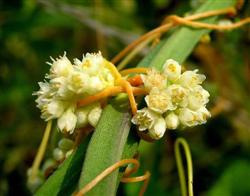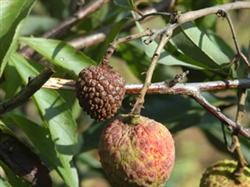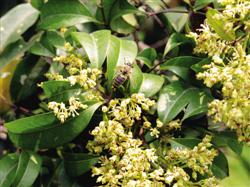How to control dodder on litchi and longan

Dodder has no roots and no leaves, but it has a zigzag sucker (or sucking roots) on the stem. It absorbs nutrients by sucking roots deep into the bark, affecting the growth of fruit seedlings and causing seedlings to die in serious days. In the mountain mature litchi orchard, it is more common that dodder can blossom and bear seeds, the flowers are small white, and the fruit will fall to the ground after ripening. The seeds germinate in the second year, and one end forms the radicle extension. The filamentous young stem is born on the surface of the top of the embryo, and the young stem grows very fast. When it meets the seedling, it wraps around it, produces sucking roots, extends into the stem of the seedling to absorb nutrition, and the stem continues to branch and elongate. At this time, the stem extended into the scholar gradually wet rot or withered and shrunk away from the soil. Control methods: (1) after the dodder is found, it should be cut together with the damaged part of the seedling (because the broken stem has the ability to develop into a new plant). Generally cut off the dodder before opening, be sure to cut thoroughly, cut the stem should be concentrated burning. (2) climbing epiphytes such as weeds as "bridge hosts" should be removed from the nursery or orchard, and dichloronitrile 0.5 kg / mu, or 2%, 3% pentachlorophenol sodium salt and dinitrophenol ammonium salt can also be used for control. (3) the seriously damaged orchards should be ploughed deeply every year, and the seeds of dodder falling on the soil surface should be turned deep into the deep soil below 3 centimeters, making it difficult to unearth. (4) the use of biological control measures, such as spraying "Lubao-1" (a fungal preparation) on cloudy days after rain, with a dose of 1.5mu and 2.5kg per mu, can artificially promote the death of dodder caused by anthracnose. It is better to break the stem of dodder before spraying. (5) spraying herbicides such as Gump Gill, Rasol, aminophos, Diletamine and other herbicides can kill dodder, as well as spraying 1.5% pentachlorophenol sodium and 2% promethazine. Or dinitroammonium salt. Spray once every 25 days for a total of 3 times.
- Prev

Cultivation and Management techniques of Litchi
Litchi anthracnose is an important disease of litchi. To harm young leaves, flowers and fruits. It caused a large number of rotten fruit and fruit drop in the mature period of litchi. [symptoms] Leaf damage often begins at the tip of the leaf, initially producing round or irregular, light brown spots, and then rapidly expanding into dark brown spots, the edge is not clear. In.。
- Next

How to protect the Fruit of Litchi Longan Mango
At present, most of litchi and longan in Guangdong Province are in the flower bud stage. Affected by the weather with high temperature and suitable humidity since the beginning of spring, litchi and longan blossoms early, diseases and insect pests occur early and the source of diseases and insect pests is relatively high after winter. it is expected that the occurrence of main diseases and insect pests in litchi and longan flowering stage is moderate and partial heavy. Litchi Toona sinensis
Related
- Moge, come on! The staff of the peasant association in the producing area of cantaloupe were frightened when the crowd gathered.
- Causes and Solutions of low Fruit setting rate of Apple
- Symptoms and control measures of passion fruit virus disease
- Fruit growing lesson: how do apple orchards keep high yields?
- Can you build orchards in the mountains? What are the pros and cons?
- How to manage the coloring period of Crisson grape?
- This paper introduces the processing technology of two kinds of fig products.
- How much is a month for retired teachers in rural areas by 2020?
- How can strawberry planting increase sugar content? We should pay attention to management in many aspects.
- What are the cultivation techniques on how to improve the yield of golden fruit?

